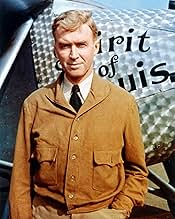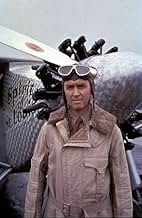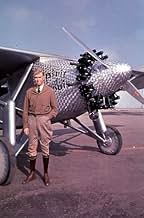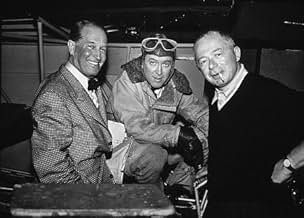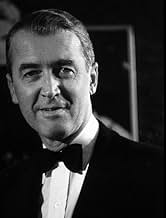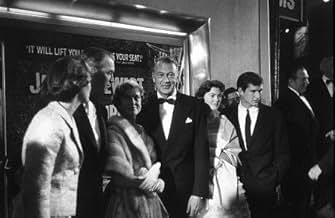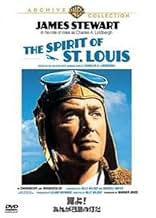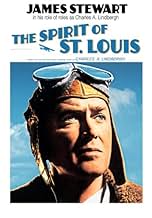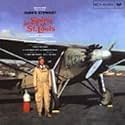Ajouter une intrigue dans votre langueCharles 'Slim' Lindbergh struggles to finance and design an airplane that will make his New York to Paris flight the first solo transatlantic crossing.Charles 'Slim' Lindbergh struggles to finance and design an airplane that will make his New York to Paris flight the first solo transatlantic crossing.Charles 'Slim' Lindbergh struggles to finance and design an airplane that will make his New York to Paris flight the first solo transatlantic crossing.
- Réalisation
- Scénario
- Casting principal
- Nommé pour 1 Oscar
- 2 victoires et 1 nomination au total
- Burt
- (non crédité)
- Mother from Oklahoma
- (non crédité)
- Clerk
- (non crédité)
- Crowd Member in France
- (non crédité)
- Crowd Member in France
- (non crédité)
- Reporter
- (non crédité)
- Dad - Farmer
- (non crédité)
- Farm Boy
- (non crédité)
- Train Passenger
- (non crédité)
- Blythe
- (non crédité)
- Crowd Member in France
- (non crédité)
Avis à la une
The film deals with little else but Lindbergh's career up to and including his monumental flight from Roosevelt Field to Le Bourget in France in 33 hours back in 1927. We see Lindbergh as a mail pilot, then attempting to raise funds to buy a plane, though a plane ended up being built by a small aircraft company. And then the flight itself - and Wilder somehow makes it suspenseful and interesting. He really captures the pilot's complete isolation with no copilot or radio, talking to himself (Stewart provides the narration), sleep-deprived, with only the sound of the plane for company, falling asleep at the wheel, and finally, unsure where he was and using map topography to figure it out. It's an amazing story. During the flight sequence, there are flashbacks to earlier points in Lindbergh's life.
The Spirit of St. Louis is replicated, and once seen, it's very hard to believe it got out of Roosevelt Field. Lightweight, Lindbergh made sure it carried only the absolute essentials and refused to even bring a parachute or radio because of the extra weight.
Today, for me anyway, James Stewart is just James Stewart, one of the great film stars and actors. I'm blissfully unaware of his age most of the time, and I was in this film as well. For me, he was tall, lanky Lindbergh, determined to succeed and very likable. I realize that John Kerr was offered the role first, but if he had taken it, the film would have flopped initially, as it did starring Stewart, due to the huge budget, but I don't believe it would hold up as well as it does today.
Heroes are very rarely discussed as human beings, and many of their words and actions are taken out of context and out of the era. Lindbergh was ahead of his time in his environmental and aeronautical pursuits and very much of his time in some of his political beliefs. And as we now know, fidelity wasn't one of his strong points. Reading an excellent, well-researched biography like Scott Berg wrote is preferable to making snap judgments. Hindsight is easy.
Complicated men have complicated lives. You don't achieve what Lindbergh did in the Spirit of St. Louis by being ordinary. Wilder does an excellent job in showing his crowning achievement, and in evoking the excitement people felt at the time.
There is a good mixture of comedy and drama throughout the film and a good use of flashbacks. It also helps that James Stewart was a pilot in real life both in the military and civilian life.
Interesting picture with plenty of thrills , emotion , biographic elements and brief touches of humor . The film is pretty well though the action does drag at times and results to be overlong . Magnificent acting by James Stewart -at age 48- who gives a real Tour De Force back by good plethora of secondaries . However , many critics felt he was too old to be believable . In fact , producer Jack L. Warner was strongly opposed to the casting of James Stewart, which he believed caused the film to flop on its release in 1957 . Colorful and evocative cinematography in CinemaScope by two awesome cameramen Peverel Marley and Robert Burks , Hitchcock's ordinary . Impressive and thrilling musical score by Franz Waxman . However , the soundtrack was re-composed but composer Franz Waxman was no longer available so veteran film composer Roy Webb was hired along with Warner Brothers Music Director Ray Heindorf to come up with new cues based on Waxman's original material . The motion picture was compellingly directed by Billy Wilder , but it was a box office flop when originally released . After the film received bad notices from preview audiences, it was extensively re-edited with some new footage shot . Rating : Above average , this one remains a quality movie for the whole family .
This exciting and inventive picture well well based on true events , these are the followings : Six well-known aviators had already lost their lives in pursuit of the Orteig Prize when Lindbergh took off from Roosevelt Field on his successful attempt in the early morning of Friday, May 20, 1927. Burdened by its heavy load of 450 U.S. gallons of gasoline weighing about 1,230 kg, and hampered by a muddy, rain-soaked runway, Lindbergh's Wright Whirlwind-powered monoplane gained speed very slowly as it made its 7:52 am takeoff run, but its J-5C radial engine still proved powerful enough to allow the Spirit to clear the telephone lines at the far end of the field "by about twenty feet or six meters with a fair reserve of flying speed". Over the next 33.5 hours, he and the Spirit faced many challenges, including skimming over both storm clouds at 10,000 ft , 3,000 m, and wave tops at as low at 10 ft (3.0 m), fighting icing, flying blind through fog for several hours, and navigating only by the stars , whenever visible , and dead reckoning before landing at Le Bourget Airport at 10:22 pm (22:22) on Saturday, May 21. The airfield was not marked on his map and Lindbergh knew only that it was some seven miles northeast of the city. He initially mistook the airfield for some large industrial complex with bright lights spreading out in all directions. The lights were, in fact, the headlights of tens of thousands of cars all driven by eager spectators now caught in "the largest traffic jam in Parisian history " . A crowd estimated at 150,000 spectators stormed the field, dragged Lindbergh out of the cockpit, and literally carried him around above their heads for "nearly half an hour".
Billy Wilder adapts from Charles A. Lindbergh's Pulitzer Prize winning novel of the same name, in what is a re-creation of Lindbergh's historical 1927 solo flight. Boosted by a considerably strong lead performance from James Stewart {himself a pilot} as Lindberg, and containing an intelligent screenplay from Wilder and Wendell Mayes, Spirit Of St. Louis is a sincerely well told story.
In what at times threatens to become a monotonous film, Wilder keeps it ticking over by using flashbacks to Lindbergh's life. After the nicely told build up to the event, such as the peril being realised as Nungesser and Coli go missing {never to be found} whilst attempting the same trip in reverse, we learn stuff like how he come to buy his first plane and his work with the flying circus. This is all relative to understanding the man and his obvious passion for flying. This also helps to give us a complete picture of Lindbergh, thus putting us with him in his isolated cockpit as he undertakes this dangerous journey. Battling isolation {his only company is a fly} and chronic tiredness, it's here where Stewart perfectly portrays Lindbergh's devotion to the task. Aided by a terrific score from Franz Waxman and Academy Award nominated effects by Louis Lichtenfield, Wilder's movie turns out to be an engaging human interest story that got a thoroughly professional production. 7/10
Le saviez-vous
- AnecdotesThe movie was a box office disaster when originally released in 1957, grossing less than $3 million and costing about $7 million.
- GaffesOn his approach to St. John's, Newfoundland in the fog, Lindbergh is depicted as being concerned about colliding with a mountain peak. However, there is no even remotely mountainous terrain anywhere in the vicinity of St. John's.
- Citations
Charles Lindbergh: Did you wait in the rain all night?
Mirror Girl: Yes.
Charles Lindbergh: Are you from New York
[City]
Mirror Girl: No.
Charles Lindbergh: Long Island?
Mirror Girl: No. I'm from Philadelphia.
Charles Lindbergh: You came all the way from Philadelphia?
Mirror Girl: I had to. You needed my mirror.
- ConnexionsFeatured in Il était une fois l'Amérique (1976)
- Bandes originalesRio Rita
(uncredited)
Music by Harry Tierney
Lyrics by Joseph McCarthy
Played on a phonograph when Lindbergh is trying to rest before the flight
Meilleurs choix
- How long is The Spirit of St. Louis?Alimenté par Alexa
Détails
- Date de sortie
- Pays d’origine
- Langue
- Aussi connu sous le nom de
- The Spirit of St. Louis
- Lieux de tournage
- Santa Maria, Californie, États-Unis(Flight Training School)
- Sociétés de production
- Voir plus de crédits d'entreprise sur IMDbPro
Box-office
- Budget
- 6 000 000 $US (estimé)
- Durée2 heures 15 minutes
- Couleur
- Mixage
- Rapport de forme
- 2.35 : 1
Contribuer à cette page



